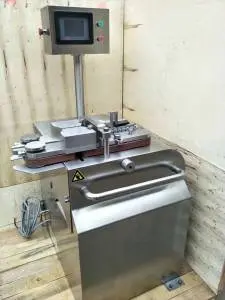
ഡിസം . 01, 2024 02:28 Back to list
meat cutting machine
The Evolution and Importance of Meat Cutting Machines
In the world of food processing, meat cutting machines have become indispensable tools, streamlining operations and enhancing efficiency in various industries—from small butcher shops to large meat processing plants. Over the years, the technology behind these machines has evolved significantly, leading to advancements that not only improve productivity but also ensure food safety and precision in meat preparation.
The Historical Background
The origins of meat cutting can be traced back to manual methods where butchers would rely solely on hand tools, such as knives and cleavers, to process cuts of meat. While skilled artisans managed to maintain a certain level of quality, the process was labor-intensive and often resulted in inconsistencies. The industrial revolution of the 19th century marked a turning point, facilitating the development of machinery that could handle various aspects of meat processing.
The first meat cutting machines were established in the early 20th century, primarily focusing on efficiency and reducing the physical strain on workers. Innovations like the band saw and grinder introduced standardization in cuts, which significantly improved the quality and presentation of meat products sold in markets. As consumer demand for convenience and variety grew, so did the need for more advanced equipment.
Types of Meat Cutting Machines
Today, the market offers a variety of meat cutting machines designed for different tasks, including
1. Band Saws Commonly used for cutting large pieces of meat into smaller sections, band saws operate with a blade that moves in a continuous loop. This technology allows for precision cutting while minimizing waste, enabling processors to maximize yield.
2. Meat Slicers Often found in grocery stores and delis, meat slicers are designed for slicing cooked or cured meats into uniform pieces. These machines are crucial for ensuring consistent thickness, which is essential for presentation and cooking uniformity.
3. Meat Grinders These machines break down larger cuts of meat into smaller pieces, making them suitable for various applications, including sausage production and ground meat products. Modern grinders often incorporate features such as multiple grinding speeds and attachment options to enhance versatility.
4. Dicing Machines For specialized cuts, dicing machines offer the capability to produce cubes and other specific shapes, catering to various culinary requirements. These machines are essential in foodservice settings where presentation is key.
meat cutting machine

Advantages of Meat Cutting Machines
The integration of meat cutting machines has brought several advantages to the food processing industry
- Efficiency Machines can operate at higher speeds than manual cutting, significantly reducing processing times. This efficiency is crucial in meeting the demands of high-volume production.
- Consistency Automated machines deliver uniform cuts, ensuring that each portion is similar in size and shape. This consistency is vital for both culinary applications and consumer satisfaction.
- Food Safety Modern machines are made with materials designed to minimize contamination risks. Additionally, they can be easily cleaned and maintained, ensuring compliance with health regulations.
- Labor Savings With machines handling the more laborious aspects of meat processing, staff can focus on other important tasks, reducing labor costs and increasing productivity.
The Future of Meat Cutting Technology
As technology continues to advance, we can expect further innovations in meat cutting machines. Automation and artificial intelligence are already beginning to play a role, enhancing efficiency and reducing the margin for error. The development of smart machines that can monitor cutting processes in real time may lead to even more precise control over meat preparation.
Furthermore, sustainability is becoming an essential consideration in the food industry, and many manufacturers are focusing on creating machines that generate less waste and are energy-efficient.
Conclusion
Meat cutting machines have transformed the food processing landscape, providing a blend of efficiency, consistency, and safety. As innovations continue to emerge, these machines will undoubtedly play a crucial role in shaping the future of meat production, catering to evolving consumer preferences while ensuring high-quality products. The journey from hand tools to modern machines reflects a commitment to progress and excellence in the meat industry, highlighting the crucial interplay between technology and culinary arts.
Latest news
-
Pneumatic Clipping Machine- Shijiazhuang Bossin Machinery|Sausage Production Line,Small Meat Shop,Supermarket
NewsAug.10,2025
-
Pneumatic Clipping Machine - Shijiazhuang Bossin Machinery Equipment Co., Ltd. | Automated Sausage Production&Precision Cutting
NewsAug.10,2025
-
Great Wall DKJC Automatic Sausage Clipper Machine | High Efficiency
NewsAug.10,2025
-
Pneumatic Clipping Machine - Shijiazhuang Bossin Machinery | Sausage Production Line, Meat Processing Equipment
NewsAug.10,2025
-
Pneumatic Clipping Machine: Efficient Sausage Production Solution|Efficient Pneumatic Operation&Seamless Integration
NewsAug.09,2025
-
Pneumatic Clipping Machine - Shijiazhuang Bossin Machinery | Precision Cutting, Compact Design
NewsAug.09,2025